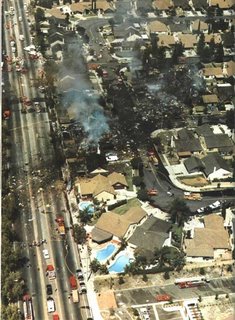A Tale of Vampires - Part 1

What does a photo of a plane crash have to do with vampires?
Read on.
Someone asked me to write here about the background of "The Haunting of Carrick Hollow," which is one of the stories you can find in the collection of my stories, Eighteen. (Some places list it as 18. Yes, I've learned my lesson about numbers as titles.)
How did I end up writing a story about vampires? Or is it really about vampires? Why did I co-write it? Who is Paul Sledzik? Were there really vampires in New England? What's the forensic science side of the story? The history? How did the story end up in a collection of historical short stories?
The story of the short story is sort of a long story, at least the way I've decided to tell it, which will be over more than one post. This will give those of you who haven't read it yet a chance to look it over (if you want to do) so before I get into spoiler territory. I'll try to avoid that as much as possible, and warn about it, but some elements of "Carrick Hollow" relate to the research and story behind it, so I can't completely separate them.
I thought it might be fun to really trace back the threads that led to the writing of "Carrick Hollow," long before the story itself first appeared in print.
So back we go...let's start with how I met my co-author, Paul Sledzik.
Before my second book was published, I realized I needed to know more about forensic science. Okay, I wanted to know more about it, too. I had enjoyed what I learned researching Goodnight, Irene. But where did a new writer learn such things?
This was long before CSI was on television, and in retrospect, I'm grateful for that, because I didn't learn about forensic science from a television drama. An author friend (and fellow CSULB alumna), Wendy Hornsby , mentioned that she had taken a good class from Larry Ragle at UC Irvine. I saw that the UCI Extension was offering it again, and signed up for it. The class met in the fall of 1992.
Larry was the Director of Forensic Sciences for Orange County, California. (Those of you who like to read about forensic science will enjoy his book Crime Scene.) The class was a perfect introduction to forensic science.
Among the many fascinating speakers he invited into the class was a forensic odontologist who talked about working with Larry Ragle and with Dr. Judy Suchey, a forensic anthropologist then on the faculty of California State University, Fullerton. He included a presentation on the recovery of remains from what was probably Orange County's biggest air disaster -- something most of the locals refer to as the Cerritos plane crash -- after the town where the planes mowed the swath of destruction you see above.
The midair collision of Aeromexico Flight 498 (a DC-9 with 56 passengers and crew of 6 aboard) and a Piper Archer (with a pilot and two passengers aboard) on August 31, 1986, caused the planes to fall into a suburb on the LA/OC border, where it killed 15 people on the ground, wounded 8 others, and destroyed or damaged a dozen houses. (Contrary to popular belief, the pilot of the Piper did not have a heart attack. You can read a full analysis of the crash from the AOPA here.) Identifying the dead was a complex and (given the chemical and other hazards from the crash) dangerous task.
I later learned that Judy Suchey was teaching classes in forensic anthropology for lay people. I found her course equally fascinating. I asked her for information on textbooks and bought a few and did my best to work my way through them. Again, although her course was packed, forensic anthropology really wasn't a hot topic, and wasn't on television dramas yet. In addition to other work as an anthropologist and teacher, Judy Suchey worked on the Charles Manson case, the Hillside Strangler case, and many others in the more than 35 years she has devoted to her field. She is also noted as an author of important studies and a developer of a number techniques in use in the field of anthropology.
Those of you who have read my novels may recall that Larry Ragle had been mentioned in my acknowledgements, and that one of the people to whom Bones is dedicated is Judy Suchey. And a presentation Judy Suchey gave was one of the sparks that led to the short story, "Two Bits." So these courses in the early and mid 1990s had an impact on both my writing and my interest in forensic science.
Later (I believe it was 1995, but I'll have to look up old program books to be sure) I was at a Malice Domestic Convention, and assigned to a panel on research. In the green room before our session, the five panelists gathered for the first time. Soon, two of the other panelists were in close conversation with the moderator. A gentleman I hadn't met sat quietly by himself. I introduced myself to him — he was Paul Sledzik. He told me he was a forensic anthropologist. I asked him if he knew Judy Suchey. He did — and soon we were talking to each other about forensic anthropology, and research, and reading. A friendship began...one I number among those most important to me.
[photographer of Cerritos air crash photo, above, is unknown]
Labels: forensic science, writing










0 Comments:
Post a Comment
Links to this post:
Create a Link
<< Home